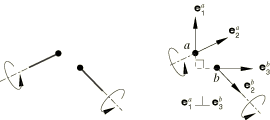UNIVERSAL | |||||||||
|
| ||||||||
ProductsAbaqus/StandardAbaqus/ExplicitAbaqus/CAE
Description

A UNIVERSAL connection constrains the rotation about the shaft directions at two nodes. The shaft directions at nodes a and b are and , respectively. A UNIVERSAL connection requires that local direction be perpendicular to . This single constraint is written
This constraint is equivalent to constraining the second Cardan angle to be zero in a Cardan angle parameterization of the local directions at node b relative to those at node a. If the initial orientation directions at node b do not satisfy the above constraint condition, the universal constraint will hold the second Cardan angle fixed at its initial value.
The constraint moment imposed by the UNIVERSAL connection is
A UNIVERSAL connection allows two free rotational components of relative motion between two nodes. The first and third Cardan angles that position local directions at node b relative to those at node a are
The two available components of relative motion for the UNIVERSAL connection, and , are the changes in the two unconstrained Cardan angles when the second Cardan angle is fixed. Therefore,
where and are the initial Cardan angles. The connector constitutive rotations are
The kinetic moment in the UNIVERSAL connection is
![]()
Friction
When used by itself, there is no predefined Coulomb-like friction in the UNIVERSAL connection. However, when the UNIVERSAL connection is used in combination with the JOIN connection type, the predefined friction is the same as the UJOINT connection.
![]()
Summary
| ||||||||||||||||||||||||||